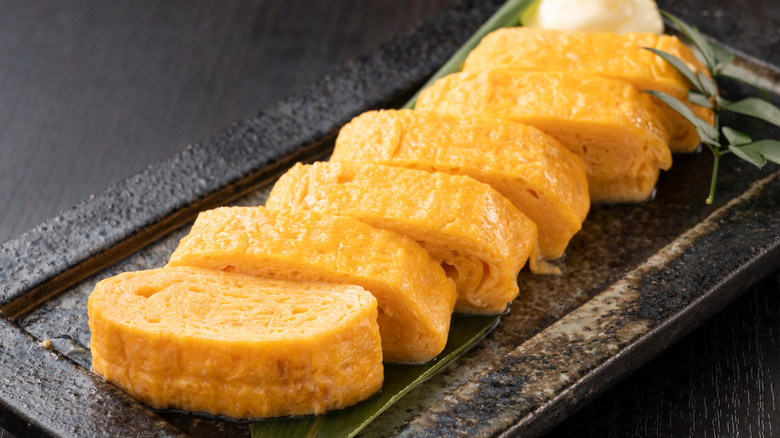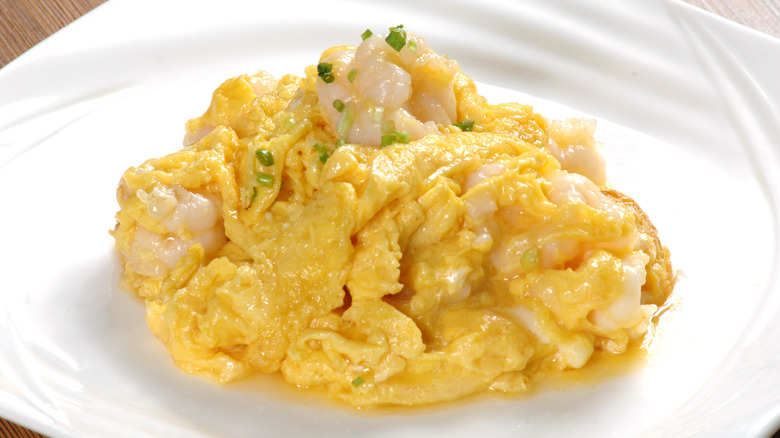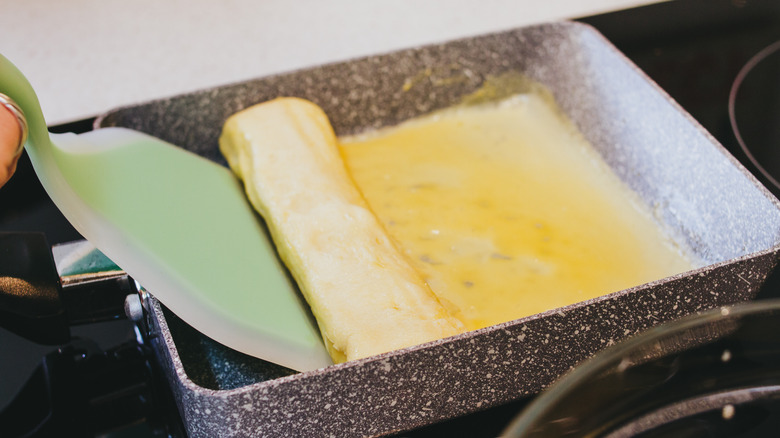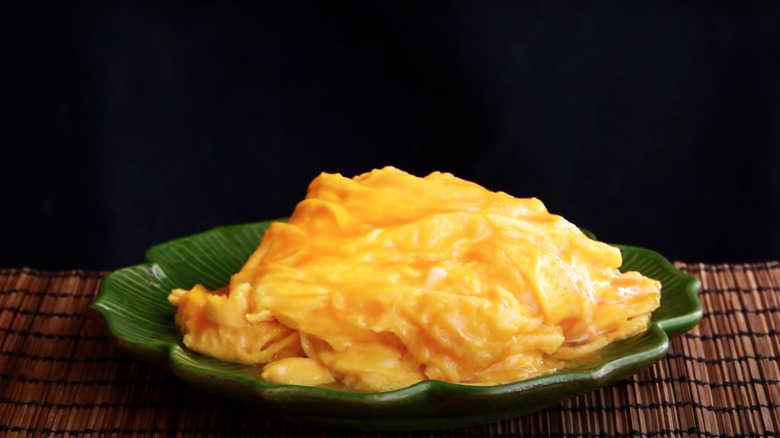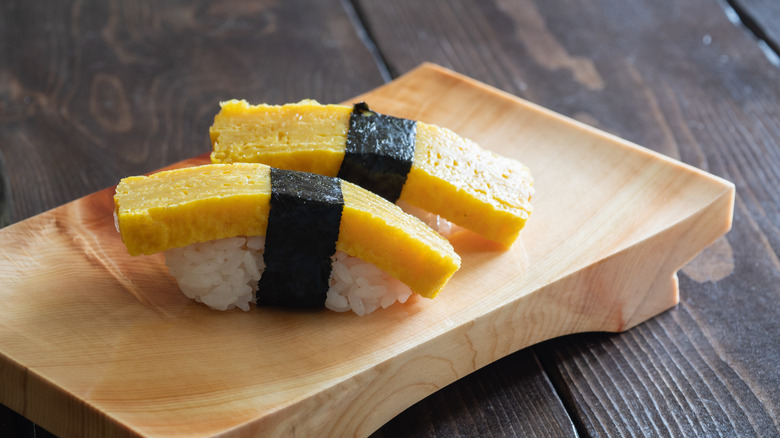The Difference Between Cantonese-Style Scrambled Eggs And Tamagoyaki
Eggs are one of the most versatile ingredients in any pantry. They can be used in anything from breakfast foods to desserts and are an integral part of endless dishes; what's a soufflé without egg? According to Mental Floss, use of the humble egg dates back to the ancient Egyptians, who regarded it as a sacred food source. So how did eggs go from a millennia-old delicacy to modern-day breakfast staple?
The answer may be found in another ancient community: That of the Romans. A Reference report notes that while it's not known for sure who first made scrambled eggs or omelets, the Ancient Romans were the first to document these delicious-at-any-time foods. Thousands of years later, cultures around the world continue to put their own spin on scrambles, omelets, and other egg dishes. Two you should definitely know about are Cantonese-style scrambled eggs and Japanese tamagoyaki. While both are simple, savory dishes, the former has plenty of eggy peaks and folds, while the latter is a fluffy, multi-layered, rolled take on the omelet.
Besides eggs, they have different ingredients
The ingredients used in Cantonese-style scrambled eggs and tamagoyaki are reflective of their respective regions' storied food cultures. Laying out the ingredients needed for Cantonese eggs, you'll get a brief introduction to the Chinese pantry and see the ways in which the cuisine showcases salty, sweet, sour, and umami flavors. The basic recipe requires ingredients like salt, white pepper, MSG powder or bouillon powder, sugar, Shaoxing wine, a cornstarch slurry, toasted sesame oil, and lard.
Similarly, if you head to the Japanese market to pick up the supplies needed for tamagoyaki, your kitchen will be equipped to make a number of Japanese soups, seafood dishes, and other staples. Like the Cantonese egg dish, tamagoyaki achieves a balance of four of the five basic tastes — sweet, sour, salty, and umami — with a handful of ingredients. The fundamentals include salt, sugar, vinegar, soy sauce, and miso, but other ingredients may be added or omitted based on personal tastes. Many people like to add mirin or sake for sweetness and acidity, as well as dashi, a Japanese soup base made with kombu (kelp) and bonito (dried fish flakes).
How to make tamagoyaki
A tamagoyaki wouldn't be Japanese without the time-honored intricacies that truly set it apart from the rest. To make one at home, you can use a traditional rectangular tamagoyaki pan or a round nonstick pan. Either is fine, but the tamagoyaki pan makes the rolling process much easier. After whisking together the ingredients in a cup with a spout (which will be handy during the cooking process), you may want to watch a few videos of the technique before heating up the pan.
A video from Just One Cookbook breaks down the steps. Prep the hot pan with an oiled paper towel before pouring in just enough of the egg mixture to coat the bottom. (Unlike a French omelet where the entire mixture is used at once, tamagoyaki are made with several layers of egg rolled into one log.) Pop any air bubbles with chopsticks, and when the flat sheet of eggs is firm, roll it up to one end of the pan, re-oil the surface, and pour in another layer of eggs, making sure to lift up the log to get some raw egg underneath. When the second layer is cooked, you'll roll it around the first layer and repeat until you've used all the eggs and have something that resembles a tube. You can perfect the cylindrical shape in a bamboo roll or simply slice the log into thick wedges after cooling slightly. Serve with optional grated daikon and soy sauce.
How to make Cantonese-style scrambled eggs
Like tamagoyaki, the best Cantonese-style scrambled eggs start with the right pan. Only this time, it's a wok instead of a rectangular one. If you don't have a wok, Chinese Cooking Demystified notes that a nonstick skillet works well with some adjustments to the technique. Once you've gathered all the ingredients you need to make the dish, it's time to crack the eggs. The key to making them extra fluffy is to separate the yolks from the whites, then gently beat the egg whites until frothy before combining with the yolks and other ingredients.
Place your pan of choice on the stove and get it piping hot before melting the lard. The next steps are a series of repetitions, so be sure to watch Chinese Cooking Demystified's video to get the hang of the method. For this dish, you'll pour in all of the egg mixture at once, then cook it for a few seconds until the sides begin to bubble and puff up. Move the pan off the burner and, using a spatula, scoop the eggs up gently from the bottom and lay them back down. Repeat this process with the goal of layering cooked egg on top of cooked egg until no uncooked mixture remains. You'll plate the eggs while they still look runny in some places; this is the style of the dish. Once you get the hang of the technique, you can experiment with adding shrimp, pork, or other proteins.
Other ways to serve these egg dishes
While both of these egg dishes can be enjoyed on their own, they can also be paired with other foods if you're craving more variety. You can enjoy tamagoyaki at any time of the day, which perfectly fits a "breakfast for dinner" philosophy. What you pair it with is entirely up to you, but Bon Appétit suggests a meal of tamagoyaki, miso soup, and white rice topped with natto (sticky fermented soybeans). You can also use it thinly sliced as a topping for hiyashi chuuka (cold ramen) or inside a fluffy white-bread sandwich with mustard, mayonnaise, and cucumbers, sliced into elegant triangles, of course.
How about the Cantonese-style scrambled eggs? In a Reddit thread with more information about the history of the dish and the cooking process, users share their favorite combinations with the moist, curd-filled eggs. Some like to add sliced tomato, which is reminiscent of the down-home Chinese dish of stir-fried eggs and tomatoes served with scallions and steamed rice. Others prefer meatier versions, like pork belly or char siu barbecue pork with yellow chives. You could even stray from the Chinese flavor profile, posters say, and try adding chorizo, lobster, or cheddar cheese.
